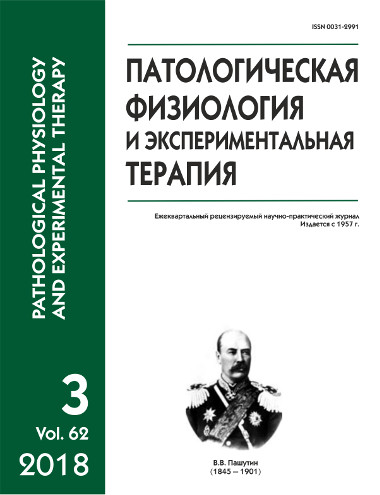Effect of 1,3,6-trimethyl-5-hydroxyuracil succinate on the antioxidant system and free-radical processes in the liver of adult and old rats treated with carbon tetrachloride
Keywords:
acute toxic hepatitis; lipid peroxidation; oxidative protein modification; age; liver; free radical; ageing; complex compound, succinate 1, 3, 6-trimethyl-5-hydroxyuracil; tetrachloromethane
Abstract
Aim. To study the effect of a complex compound, 1,3,6-trimethyl-5-hydroxyuracil succinate, on the antioxidant system and free radical processes induced by carbon tetrachloride in the liver of adult and old rats. Methods. The study used sexually mature animals aged 12 months and weighing 250 g and old animals aged 24 months weighing 395 g (total n= 60, 30 rats in each age group). Toxic damage of liver was induced by subcutaneous injections of a 50% oil solution of carbon tetrachloride (CTC) at 2 g/kg for 4 days. Together with the toxicant, experimental animals were injected with a water solution of a complex compound, succinate 1,3,6-trimethyl-5-hydroxyuracil, at a dose of 2.5 mg/100 g, i.p., 3 times per day for the first 4 days and once daily for the following 3 days. Experimental animals were used as controls, which were administered saline in the same volume. Oxidative modifications of proteins, lipid peroxidation (by levels of thiobarbituric acid reactive substances (TBARS), lipid hydroperoxides, and conjugated dienes) were studied. Condition of the antioxidant system was evaluated by activities of superoxide dismutase, catalase, and glutathione peroxidase using biochemical methods. Antiradical activity of the complex compound and its components was studied in a model system of ethylbenzene-glacial acetic acid; the K₇ constant of the rate of peroxide radical interaction with molecules of the studied compound was compared with the reference antioxidant ionol with vitamin E. Results. Succinate +1.3.6-trimethyl-5-hydroxyuracil, considerably reduced TXM hepatotoxicity in adult and old rats; removed the disbalance in free radical systems of protein oxidation in old rats; significantly improved indexes of free-radical oxidation (FRO) of hepatic lipids in adult and old rats; decreased levels of LP products, hydroperoxides, conjugated dienes, and TBARS, and enhanced performance of the antioxidant system (AOS) by increasing activities of catalase, superoxide dismutase, and glutathione peroxidase. The study demonstrated a high antiradical activity of the study drug comparable with the activity of the reference antioxidant, ionol. Сonclusion. Succinate and its derivatives can perform as individual substances with a direct antiradical mechanism of action rather than as stimulators of enzymic systems of antioxidant defence.Downloads
Download data is not yet available.
Published
05-10-2018
How to Cite
Gabdrakhmanova I. D., Myshkin V. A., Enikeyev D. A., Gimadieva A. R. Effect of 1,3,6-trimethyl-5-hydroxyuracil succinate on the antioxidant system and free-radical processes in the liver of adult and old rats treated with carbon tetrachloride // Patologicheskaya Fiziologiya i Eksperimental’naya Terapiya (Pathological physiology and experimental therapy). 2018. VOL. 62. № 3. PP. 55–59.
Issue
Section
Original research






